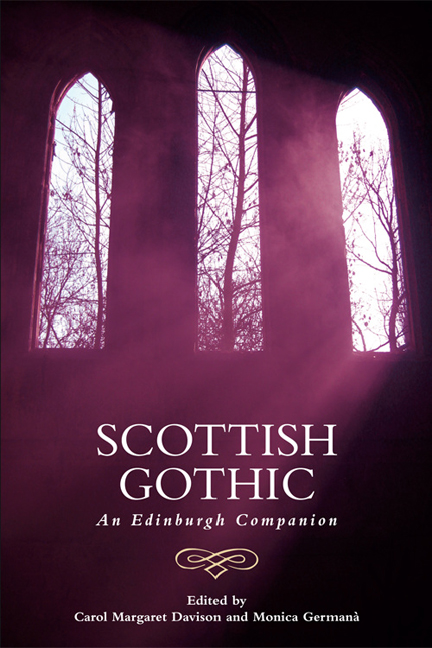Book contents
- Frontmatter
- Contents
- Acknowledgements
- 1 Borderlands of Identity and the Aesthetics of Disjuncture: An Introduction to Scottish Gothic
- 2 ‘The Celtic Century’ and the Genesis of Scottish Gothic
- 3 The Politics and Poetics of the ‘Scottish Gothic’ from Ossian to Otranto and Beyond
- 4 Robert Burns and the Scottish Bawdy Politic
- 5 Scottish Gothic Drama
- 6 Scottish Gothic Poetry
- 7 Calvinist and Covenanter Gothic
- 8 Gothic Scott
- 9 Gothic Hogg
- 10 ‘The Singular Wrought Out into the Strange and Mystical’: Blackwood's Edinburgh Magazine and the Transformation of Terror
- 11 Gothic Stevenson
- 12 J. M. Barrie's Gothic: Ghosts, Fairy Tales and Lost Children
- 13 The ‘nouveau frisson’: Muriel Spark's Gothic Fiction
- 14 Scottish Gothic and the Moving Image: A Tale of Two Traditions
- 15 New Frankensteins; or, the Body Politic
- 16 Queer Scottish Gothic
- 17 Authorship, ‘Ghost-filled’ Islands and the Haunting Feminine: Contemporary Scottish Female Gothic
- Notes on Contributors
- Index
12 - J. M. Barrie's Gothic: Ghosts, Fairy Tales and Lost Children
Published online by Cambridge University Press: 20 December 2017
- Frontmatter
- Contents
- Acknowledgements
- 1 Borderlands of Identity and the Aesthetics of Disjuncture: An Introduction to Scottish Gothic
- 2 ‘The Celtic Century’ and the Genesis of Scottish Gothic
- 3 The Politics and Poetics of the ‘Scottish Gothic’ from Ossian to Otranto and Beyond
- 4 Robert Burns and the Scottish Bawdy Politic
- 5 Scottish Gothic Drama
- 6 Scottish Gothic Poetry
- 7 Calvinist and Covenanter Gothic
- 8 Gothic Scott
- 9 Gothic Hogg
- 10 ‘The Singular Wrought Out into the Strange and Mystical’: Blackwood's Edinburgh Magazine and the Transformation of Terror
- 11 Gothic Stevenson
- 12 J. M. Barrie's Gothic: Ghosts, Fairy Tales and Lost Children
- 13 The ‘nouveau frisson’: Muriel Spark's Gothic Fiction
- 14 Scottish Gothic and the Moving Image: A Tale of Two Traditions
- 15 New Frankensteins; or, the Body Politic
- 16 Queer Scottish Gothic
- 17 Authorship, ‘Ghost-filled’ Islands and the Haunting Feminine: Contemporary Scottish Female Gothic
- Notes on Contributors
- Index
Summary
In his obituary of J. M. Barrie, George Bernard Shaw called his plays ‘ terrifying’. Although Peter Pan (first performed in 1904) had long become a cherished children's fantasy and a staple of Christmas theatricals, Shaw seemed more perturbed than enchanted by it (1993: 151). Barrie is seldom described as a Gothic writer, although his own well-known and often reductively understood biography has been ‘Gothicised’ into a dark psycho-narrative. Rather than use the latter to suggest Barrie's election to the Scottish Gothic canon, this chapter takes its cue from recent work by R. D. S. Jack (2010), Valentina Bold and Andrew Nash (2014) and others, who demonstrate how Barrie is a writer of complexity and contradiction. The generic and thematic range of Barrie's writing means that he is not a consistent or fully fledged Gothic writer but nevertheless Gothicism still inks a recurrent pattern of motifs and ideas in his work. This chapter singles out three texts in particular from the first three decades of the twentieth century: the novella, Farewell Miss Julie Logan (1931); the play, Mary Rose (1920), which Alfred Hitchcock had a long, unrealised dream of filming (McBride 2001: 24); and Peter Pan, here discussed in its incarnations as both drama and prose text (1902; 1904; 1906). It suggests that Barrie's Gothicism most arrestingly coheres in the mode of the ghost story, retrospectively echoing the conventions of the classic late Victorian ghost story whilst mirroring the psychological complexities of contemporary Modernist supernatural fictions (see Briggs 1997; Riquelme 2008; Smith 2010; Thurston 2012). In its delicate yet complex obsession with themes of death and loss, memory and the past, his spectral writing provides evidence of an engagement with Scottish national Gothic, specifically in the persistent portrayal of historical and psychological ‘pasts’ which cannot be exorcised, and in the use of thematic and aesthetic motifs from traditional folkloric belief. This chapter suggests, however, that this engagement is subtly manifest as an ambivalence towards a past that is simultaneously feared and desired. In its imaginative obsession with loss – with the consequences of ‘calling back’ the missing or the vanished – and ultimately with the figure of the child beyond reach, Barrie's writing is an intensely ‘affective’ form of Gothic.
- Type
- Chapter
- Information
- Scottish GothicAn Edinburgh Companion, pp. 155 - 167Publisher: Edinburgh University PressPrint publication year: 2017

